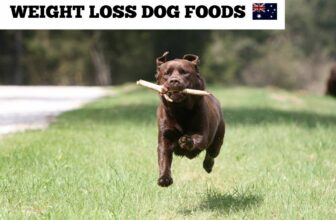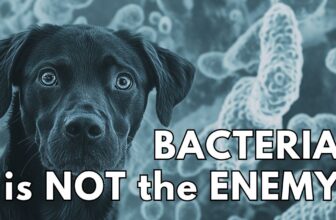BARF

You’ve heard BARF is great and will work wonders for your dog’s health, but what if I told you there’s one big problem which can lead to all manner of health issues for your dog?
It’s not about bad bacteria and pathogens either.
It’s about dental health – periodontal disease – which can leave your dog very sick.
BARF (Biologically Appropriate Raw Food) has many benefits for the health of your dog (or cat), and in many ways I’m a huge fan of this way of feeding. Compared to kibble it wins hands down, but only if you take note of the important points I cover in this article.
If you’re in Australia, I will cover what I consider the best BARF dog and cat foods available to us, whether you buy in one of the big pet stores or online.
In this guide to BARF we will cover the following:
The big problem with BARF – Ground bones
BARF was invented by Australian vet Dr Ian Billinghurst.
In 1993 Billinghurst released a game-changing book, Give Your Dog A Bone. It’s a brilliant book, and I urge you to read it if your want your dog to have a healthy life.
There’s also some irony.
The title of Billingshurst’s book emphasises the importance of raw meaty bones for our dogs, to quench their natural desire to chew on flesh and gnaw on bone, and also because raw meaty bones are the best way for our dog’s to fight plaque and tartar and maintain impeccable dental health.
With BARF, which you’ll know to be soft patties with ground bone, these benefits are completely negated. There’s nothing for your dog to chew and gnaw on.
Generally I’m not concerned about salmonella, E. coli, and other bacteria from raw meat. Yes, we need to take precautions and use common sense, but I rarely see dogs or cats affected by these risks. In fact, we are at more risk, but that’s why we take precautions, clean up, and wash our hands.
The biggest risk I see to pets fed BARF are rotting teeth and gums. I’ve seen middle-aged pets with rotting teeth and gums on soft wet diets, and believe me, it’s very sad to see, and not something you want for your pet.
Understanding BARF, then and now
At the time of writing, BARF has been around over quarter of a century.
I grew up as a kid in the 1980s, and like most family dogs, our Golden Retriever was fed a dry dog food – Pedigree in fact, which is still around and not much different today.
Pedigree is a brand made by Mars, and decade on decade the dry dog food we buy continues to be dominated by Mars and Nestle.
In fact, in the 1980s, almost all dogs were fed dry dog food. Biscuits as we call them in Australia, and kibble elsewhere.
You could say we were all brainwashed back then. Corporate marketing departments gave us wonderfully convincing TV ads to convince us their products were not only the best we could give our pets, but in some cases the only products if we wanted our pets to be healthy.
There was no Internet, no means of mass communication or sharing information, even common sense. It was a golden age for pet food companies, and that’s why we all fed our pet carnivores products made almost entirely of cereal grains with added food colourings.
Our Golden Retriever, like many dogs of the era, died a horrible death. Cancer. Tumours. I remember the putrid smell to this day of the growth which grew around her eyes before we had her put to sleep.
Dr Ian Billinghurst, working with sick dogs each and every day, realised the connection between pet food products and the poor health of pets coming through his practice.
In America, commercial pet foods had dominated for decades, but in Australia the grip of these companies was delayed due to many Australians still feeding their pets raw meats and table scraps. Billinghurst began to see the devastating change in pet health as commercial pet foods became the norm in Australia. As it’s easy to scare pet owners, many Australians began to believe raw meats and table scraps were unhealthy, and if their pet touches a bone they could die.
The BARF diet was born from that realisation, and to offer pet owners something better, healthier, and more normal for their pet to eat.
That’s what prompted Billinghurst to write Give Your Dog a Bone, and offer Australian pet owners what was essentially the first commercial BARF product – Dr B’s BARF.
And it was a much better alternative.
The concept of BARF quickly took off and spread across the globe.
In the US, as the Internet became more readily available, BARF groups started to form and grew in size. You could argue BARF reached cult status in the early 2000s, and the health of many dogs and cats benefited from it.
Thankfully these days we have many better commercial dog foods, from BARF to dried raw to slightly cooked meals delivered straight to your door.
I write this in 2024, which has seen BARF benefit many pets over the last quarter of a decade.
BARF is far more appropriate than most commercial pet foods, and much healthier for our pet carnivores than the processed nuggets of grain which are still being sold and fed by many to their helpless pets.
How to tackle the BARF “Bone” problem, considering calcium to phosphorous ratios
You may have heard of the term “complete and balanced”?
Pet food standards set by organisations such as the Association of American Feed Controls Officials (AAFCO) set in place requirements for pet foods to have enough protein, fat, vitamins, minerals, and ratios such as calcium to phosphorous.
We don’t have regulations such as this to dictate our own diets. Isn’t that odd?
We achieve balance, hopefully, from variety (assuming we eat proper foods). We have some bad stuff too, but the end result is hopefully a good balance of all the nutrients we need.
With our dogs and cats we have been trained to believe they must eat the same product, day in, day out, for their whole lives. We bring home our first pet, and we assume we must feed them one particular brand – prove me wrong!
This is the reason those products must be “complete and balanced”. They must contain all the required nutrition your dog and cat needs, in the correct balance and ratios, because if they don’t your pet will eventually get sick.
When it comes to BARF, such as the BARF patties we can buy in most pet stores these days, these adhere to those very standards. We rely on them completely to meet all the complex nutritional needs of our pets, in the correct balance, including calcium and phosphorous.
That means adding raw meaty bones to a BARF diet would put the balance of nutrients, particularly calcium to phosphorous, out of whack, would it not?
We now know BARF won’t help our dogs and cats fight of dental decay and periodontal disease, yet adding raw meaty bones will disrupt the precious “balance” we are taught is essential to the health of our pets.
So what do we do?
Here are a few possible solutions:
Possible Solution #1: What I do – Variety
I’ve had pets for decades, and in some ways I have learned the hard way. It took me many years to peel back the marketing and brainwashing and realise feeding our pets is easier than we’ve come to believe.
This may not work for everyone, and admittedly I have confidence I meet the many nutritional requirements of my pets. However, I don’t weigh every morsel I feed them, and I don’t cross-reference a complex Excel spreadsheet of nutrients and ratios.
I simply feed my pets a variety of appropriate foods based on their carnivorous nature (my cat is a carnivore, and I consider my dog more carnivore than an omnivore like us).
My pets have raw meaty bones – chicken necks, wings, drumsticks, and other appropriate bones.
They also have commercial foods – raw, BARF, some wet, some dry, air-dried, freeze-dried, usually dictated by what’s available, on offer, or how long ago pay day was.
I feed them raw meats, raw organs, eggs, fish, appropriate table scraps (mostly meat, but some veggies). Sometimes I cook up some liver (my dog turns her nose up at raw liver), and I add a little garlic, turmeric, or herbs.
I make bone broth regularly, for both myself and my pets. Whole chicken in the slow cooker, a little apple cider vinegar, and again perhaps some garlic or other beneficial ingredients.
On hot days, my dog loves to much on ice cubes with chia seeds.
I have fed my pets for many years what some may call a “hybrid diet” today.
As I feed my pets in such a way, why would I care about each and every food I feed them being “complete and balanced”?
I reach balance with variety.
Possible solution #2: The 10% rule
This is an easy one if you don’t know where to start.
The 10% rule should work whatever type of food you feed your dog – dry food, wet food, raw, BARF patties. If you consider those “complete and balanced” foods your pets main diet, accounting for around 90%, you can freely feed them 10% other stuff of your choosing, such as raw meaty bones, appropriate treats, or healthy table scraps.
Treat companies advise you to keep treats to 10% of your pet’s diet. Needless to say most pet treats are sugary starchy rubbish, which means it’s essential to limit those treats – otherwise your pet may get sick, or fat.
What if those treats were healthy?
Dried meat-based treats, a nice crunchy carrot, or raw meaty bone?
Why not give your dog a raw meaty bone 2 or 3 times a week? This can easily be part of that 10%, and you shouldn’t feel like you’re putting the essential “balance” out of whack.
Possible solution #2: Dental treats and toys
When I say “dental treats”, I mean dry chews made from animal-products, such as beef jerky, deer tendon, or bull penis (yes, this is a thing – bully sticks).
I don’t mean Greenies or Dentastix or any other treat made of starch and sugars which apparently benefit your pet’s teeth based on texture.
When was the last time you cleaned your teeth with sugary cereals?
Some toys, such as Kong, may benefit your dog in terms of dental health, but personally I wouldn’t rely on them. You could argue your favourite work shoes or chair legs will help scrape off that plaque and tartar, but you’re far better off giving them some dried meat chews or a raw meaty bone, aren’t you?
Possible solution #3: Dental checks and cleaning
If you’re adamant about feeding BARF, don’t want to feed raw meaty bones because of the risks (which is fine), and you baulk at the cost of dried meat chews (they’re expensive, right?), then you absolutely must do the following:
- Periodically check the condition of your pet’s teeth. Is there any plaque or tartar? Are their teeth in good condition?
- Keep in mind no commercial food or dental treats will truly help keep your pet’s teeth clean, and regular check-ups by your local veterinarian are always a good idea. Quite often our vets pick up on issues we completely miss as pet parents, because that’s what they’re trained to do.
- Although my personal preference is raw meaty bones to prevent plaque and tartar build-up in the first place, getting their teeth professionally cleaned can and will help keep their health in check.
Australian BARF patties
The original Dr B’s BARF has long since been acquired by The Real Pet Food Co, one of our largest pet food manufacturers. Another long standing, and successful Aussie BARF food is Big Dog BARF.
Over the years some other brands have hit the shelves. Many are really good and high quality, so it may depend on where you shop.
Most pet food stores in Australia have a freeze section these days, and you’ll find a range of BARF options for your dog or cat.
Here are relevant reviews of recommended BARF pet foods in Australia:







Love this review. Very informative.